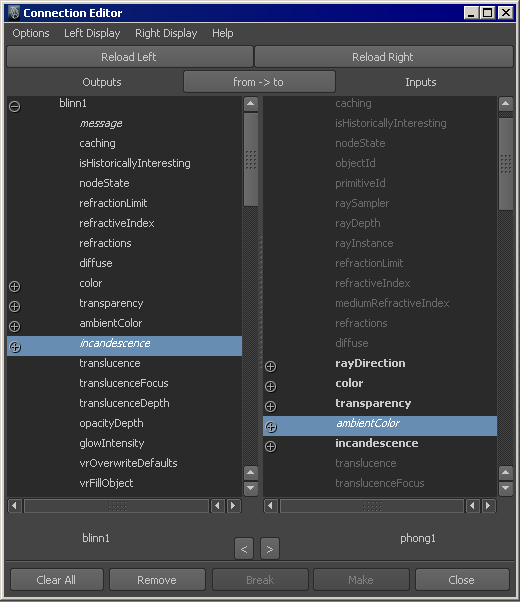Navigate to Windows > General Editors > Connection Editor.
The Connection Editor provides node connection information in a side-by-side layout where you can view two connected nodes in a network. This editor is useful for fine-tuning a shading network.
You can quickly and easily traverse from node to node and show a node’s outputs or inputs to facilitate connections, meaning you can make connections in either direction in a node network.

Some utility nodes can only be connected to a material’s attributes through the Connection Editor.
Connected attributes in the Connection Editor appear in italics (Mac OS X excepted), while non-keyable attributes appear dimmed. Some dimmed attributes indicate a nested list of attributes. Double-click the attribute, or expand the attribute to view the connectable nodes.
To connect nodes with the Connection Editor, see Connect nodes by dragging them.
Connection Editor buttons
The Connection Editor’s buttons control how connections are made.
- Reload Left and Reload Right
-
Loads a node into the output or input panes of the Connection Editor. Select a node, object, or shader and click Reload Left or Reload Right.
- from -> to
-
Switches the output attributes to input attributes, and the input attributes to output attributes.
- Arrow buttons (

 )
) -
Moves the output node into the input pane (
 ), or moves the input node into the output pane (
), or moves the input node into the output pane ( ).
). - Clear All
-
Removes the nodes from the output and input panes.
- Remove
-
Removes the node in the output pane.
- Break
-
Breaks the selected connection. Select the connection you want to break from the output pane, then click Break. This button is only available when the Auto-connect option is off.
- Make
-
Makes a connection between the selected attributes. Select an output attribute, and select an input attribute, then click Make. This button is only available when the Auto-connect option is off.
- Close
-
Closes the Connection Editor.
Connection Editor menu bar
- Options > Auto-connect
-
Causes a connection to be created automatically, when you select an output attribute and an input attribute. This option is on by default.
- Options > Channel Names
-
Changes the way the attributes are displayed in the Connection Editor. The Nice setting displays the names in the most readable manner with leading capitalizations and spaces. The Long setting displays the attributes in the same manner as nodes are displayed. The Short setting displays names as short forms, for example, Bounding box displays as bb.
- Options > Attribute Order
-
Changes the order in which the attributes are displayed in the Connection Editor’s list. Attributes can be sorted in ascending or descending alphabetical order.
- Left Display > Show Readable and Right Display > Show Readable
-
Displays all the attributes for the node, regardless of whether the attribute is keyable or not. This option is on by default.
- Left Display > Show Outputs Only and Right Display > Show Outputs Only
-
Displays only the output connections for the selected node.
- Left Display > Show Inputs Only and Right Display > Show Inputs Only
-
Displays only the input connections for the selected node.
- Left Display > Show Published Only and Right Display > Show Published Only
-
Display only published attributes for the selected asset node.
- Left Display > Show Non-Keyable and Right Display > Show Non-Keyable
-
Displays the non-keyable (attributes you cannot create connections for) attributes of the node. This option is on when the Show Readable option is on.
- Left Display > Show Connected Only and Right Display > Show Connected Only
-
Displays only the attributes that have connections.
- Left Display > Show Hidden and Right Display > Show Hidden
-
Displays hidden attributes for the node.